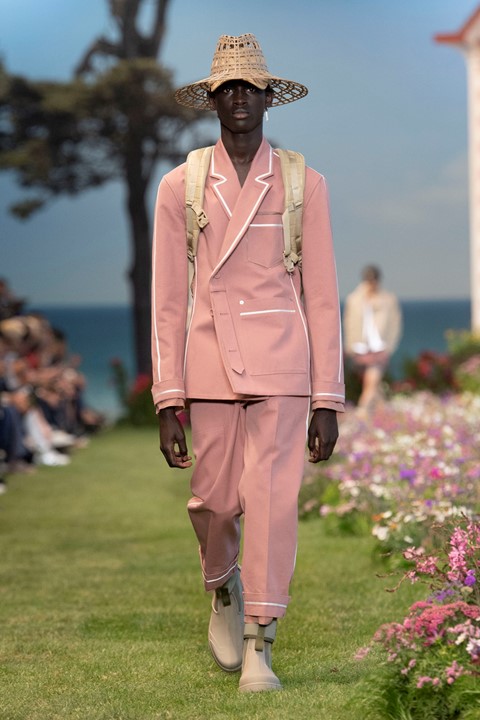Kim Jones’ Summer 2023 menswear collection for Dior derived inspiration from Charleston House and its infamous, unruly garden. Here, we delve deeper into the Bloomsbury Set’s countryside retreat and what it meant for British art and culture
Growing up in Lewes in East Sussex, Kim Jones always knew of the peculiar history of Charleston House and its infamous garden – an old, eccentric farmhouse that used to be home to members of the Bloomsbury Set. But it was on a trip to Charleston when he was 14 years old that Jones discovered the sheer importance of the house with regards to the cultural fabric of British art and culture. Taking inspiration from Charleston’s long-term inhabitant and guardian, the artist Duncan Grant, Jones’ latest menswear collection for Dior is a celebration of the man and the house that he called home for over 50 years.
Here, in a five-point guide, we take you on a journey through the history and legacy of Charleston House, and celebrate its invaluable influence on not just Jones, but on British culture itself.
Duncan Grant
The singular muse to Jones’ latest collection, Duncan Grant was a painter and designer who moved to Charleston in 1916 with his close friend and one-time lover, Vanessa Bell. Their relationship was a strange one: Grant was a gay man and Bell was a married woman, yet they bore a child together and continued living at Charleston for over four decades. Grant’s art is post-impressionist in style – the thick, impasto brushstrokes of his portraiture and the bright, unreal colours of his landscapes and still lifes display a penchant for the abstract, a movement that was still in its infancy when Grant arrived at Charleston. His personal life was as varied as his artwork; he had numerous affairs with notable male members of the Bloomsbury Group such as Lytton Strachey and John Maynard Keynes. Grant stayed at Charleston until his death in 1978, and was the guardian of the house and its treasures for over 60 years.
The Bloomsbury Group
Grant and Bell were members of a legendary group of artists, writers and creatives that sprung up in London in the early 20th century. Due to the group’s proximity to the Bloomsbury district of London, they became known as the Bloomsbury Group and were very much the proto-influencers of their day. At their helm was Virginia Woolf, her husband Leonard Woolf, the novelist EM Forster, the economist John Maynard Keynes, the critic Roger Fry and, of course, the painter Duncan Grant. The talk of London town during the 1910s and 20s, the group would often pack up everything and escape to Charleston – their countryside retreat. As a result, Charleston House became one of the most significant artist retreats in the country, something that its walls and garden can very much attest to.
The Interior
One of the most significant and overwhelming aspects of Charleston is its maximalist interiors. Grant and Bell treated the house not as a simple dwelling but saw its every surface as a blank canvas. There isn’t an inch that doesn’t seem studied, from the garishly clashing interior walls and the hand-painted murals that surround the fireplaces, to the artworks hanging without an inch between them and the grand Persian rugs that lay, piled-up, on the floors. Everything is frantically considered to give the illusion of chaos. Many of the artworks on the walls are by Grant and Bell themselves, but there are also a number of pieces from their vast art collection, including works by the famed British artist Walter Sickert and their close friend, Roger Fry.
The Garden
Roger Fry was an art critic, painter and a central member of the Bloomsbury Group. One of his most significant contributions to art was the term ‘post-impressionism’, which he coined in 1906 to describe artists such as Paul Cézanne and Paul Gauguin who had pushed past the mere impressionism of Monet and into a realm where artworks aimed to make you aware of their creation through the use of thick paints and blurry abstraction. In 1918, bored of the plain, conventional garden at Charleston, Grant and Bell asked Fry to design a new garden. The result was one of a kind. A garden-cum-auditorium-cum-exhibition space, the garden is a shock of colour and life, teeming with wildflowers and kept guard by several life-size sculptures by Bell’s son, Quentin Bell. It became to Bell and Grant their very own Giverny (Monet’s home) – a constant source of inspiration for their still lifes and landscapes.
The House Today
In the years since Bell and Grant’s passing, Charleston has passed into the hands of the Charleston Trust, a charity which maintains and guards not only the physical legacy of the house and its garden, but the legacy of Bell, Grant and the Bloomsbury Group as a whole. In recent years, they’ve hosted the Charleston Festival, a ten-day arts festival that attracts speakers from the worlds of literature, film, art and fashion. The most recent edition of the festival featured a line-up including Armistead Maupin, Zandra Rhodes, Sheila Hancock and, in a wonderfully full-circle moment, Kim Jones.






